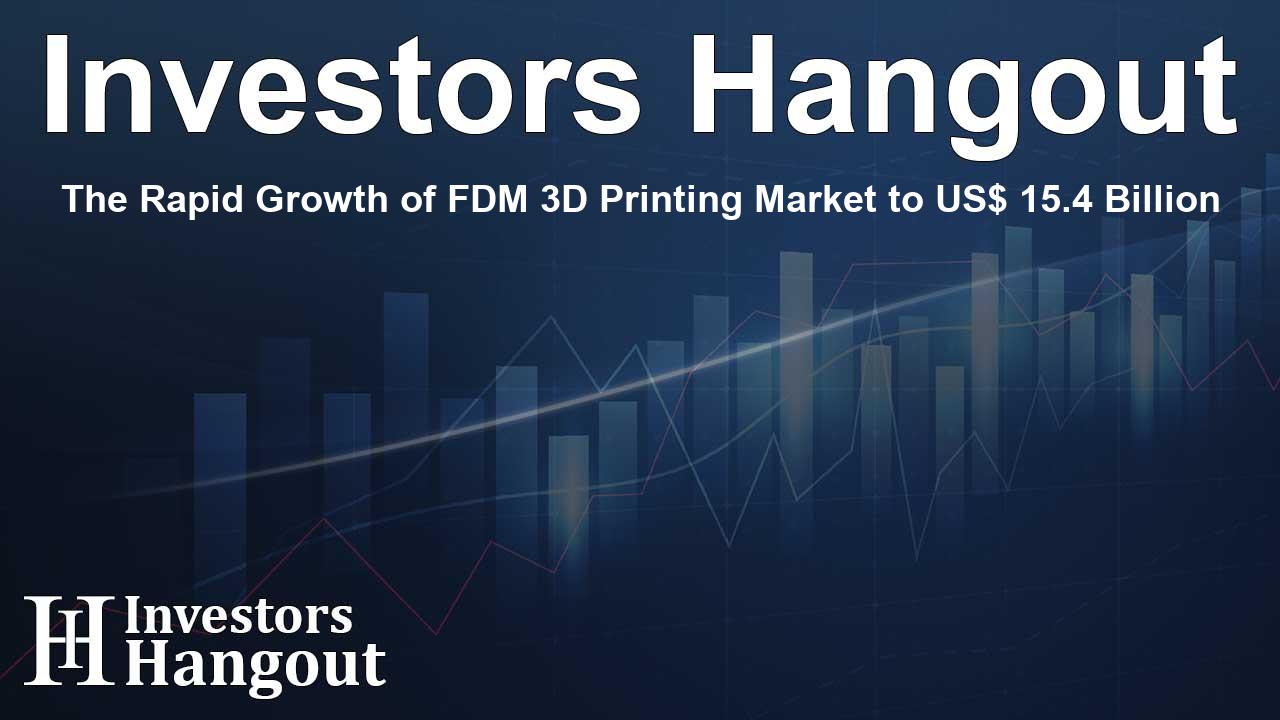The Rapid Growth of FDM 3D Printing Market to US$ 15.4 Billion

Understanding the Fused Deposition Modeling (FDM) 3D Printing Market
Comprehending the current landscape of the global fused deposition modeling (FDM) 3D printing market reveals remarkable growth and innovation. Valued at approximately US$ 2.8 billion recently, the sector is anticipated to surge to around US$ 15.4 billion by 2033, marking an impressive compound annual growth rate (CAGR) of 20.9% throughout the forecast period. This robust growth indicates a vibrant market that consistently attracts investment and interest.
Key Drivers of Growth in the FDM Market
Market vitality is evident in the rising unit sales figures. In just the first half of a recent year, the global sales of 3D printers reached an impressive 2.152 million units, with projections indicating that total sales might surpass 4.5 million units by the year's end. A significant contributor to this growth is the Chinese manufacturing sector, which exported 1.829 million 3D printers between January and June of that year, predominantly desktop models reliant on FDM technology. The average price of these exported desktop printers, at only 317 dollars, has made this technology highly accessible to consumers and businesses alike.
Industrial Growth and Prototyping
Notably, established companies outside of China like Prusa have also shown substantial growth, with an impressive shipment of over 120,000 printers in the year leading up to 2024. As industries embrace on-demand manufacturing techniques, 3D printing allows for lead times to be significantly reduced—by 40-60% in many cases—when compared to traditional manufacturing methods. This aspect alone fuels demand within a dynamic FDM market, pushing it steadily upwards.
Comparative Market Analysis and Competitive Landscape
The competitive landscape of the FDM 3D printing market is marked by numerous strategic maneuvers from established players looking to enhance their market presence. For instance, Stratasys, a renowned leader within the industry, has projected an annual revenue of between USD 570 million and 585 million for the upcoming year. Innovations, such as Vision Miner’s new high-temperature IDEX FDM systems, and Endless Industries GmbH’s launch of the Endless One 3D printer have highlighted a continual evolution towards productivity and efficiency.
Impact of Adoption Rates
Adoption rates signal a burgeoning confidence among users. In a recent survey involving over 700 engineers and designers, approximately 70% reported an increase in production capacity compared to the previous year, with 82% acknowledging that 3D technology facilitated significant cost savings. This trend is likely to further boost the FDM printing market, with major automotive companies like Subaru and McLaren already utilizing this innovative technology for production and component manufacturing.
Sustainable Materials Driving Innovation
An integral aspect of the FDM market’s growth trajectory is the innovation of materials used in 3D printing. The global market for 3D printing plastics is projected to rise from USD 2.36 billion to USD 5.39 billion by 2030, driven by the escalating demand for customization in crucial sectors like automotive and aerospace. Demand for high-performance filaments, particularly advanced composites and bio-based options, is surging, revealing a clear trend towards sustainable practices.
Material Evolution and Sustainability
The adoption of advanced materials, such as metal-infused and high-performance plastics, has expanded the scope of FDM applications, enabling broader use in both prototyping and final production across various industries. Material innovations have been noteworthy, with a 15% increase in demand for PEEK and ULTEM materials over the last year, demonstrating a robust shift in market essentials toward more durable and versatile printing solutions.
Shifts in Industrial Manufacturing and Applications
The landscape within industrial manufacturing shows a clear transition from prototyping to the production of final parts, marking a pivotal phase in the FDM market. Valued at USD 3.56 billion in the current year, the industrial 3D printing segment alone is poised to grow significantly, corroborated by a notable percentage of manufacturing professionals opting for FDM technology over traditional methods. Firms in transportation and robotics showcase high adoption rates for creating end-use components, pivoting towards greater efficiency and speed.
Future Directions for FDM Technology
The future of the Fused Deposition Modeling market is not just about growth but encompasses a vision that includes the integration of artificial intelligence. Experts are optimistic that 2025 will usher in a new era characterized by full industrialization of FDM processes, shifting the focus from mere prototyping to mass production capabilities. The potential for AI-driven quality control mechanisms to minimize failures represents a defining moment for the industry.
Conclusion
Overall, the FDM 3D printing market stands on the cusp of transformative advancements. With emerging trends pushing the boundaries of traditional manufacturing, this innovative technology is set to redefine various industry landscapes, confirming its status as a significant enabler for future innovations.
Frequently Asked Questions
1. What is the projected value of the FDM 3D printing market by 2033?
The FDM 3D printing market is projected to reach approximately US$ 15.4 billion by 2033, growing at a CAGR of 20.9%.
2. How much of a decline in lead times can 3D printing provide?
3D printing can reduce lead times by 40-60% compared to traditional manufacturing methods.
3. What role do innovative materials play in the FDM market?
Innovative materials are crucial for growth, with demand for advanced composites and bio-based materials significantly increasing.
4. Which industries show the highest adoption rates for FDM technology?
The automotive and healthcare sectors are leading in the adoption rates of FDM technology for both prototyping and production.
5. What does the integration of AI mean for the future of FDM 3D printing?
The integration of AI is expected to enhance accuracy, efficiency, and real-time quality control in FDM manufacturing processes.
About The Author
Contact Hannah Lewis privately here. Or send an email with ATTN: Hannah Lewis as the subject to contact@investorshangout.com.
About Investors Hangout
Investors Hangout is a leading online stock forum for financial discussion and learning, offering a wide range of free tools and resources. It draws in traders of all levels, who exchange market knowledge, investigate trading tactics, and keep an eye on industry developments in real time. Featuring financial articles, stock message boards, quotes, charts, company profiles, and live news updates. Through cooperative learning and a wealth of informational resources, it helps users from novices creating their first portfolios to experts honing their techniques. Join Investors Hangout today: https://investorshangout.com/
The content of this article is based on factual, publicly available information and does not represent legal, financial, or investment advice. Investors Hangout does not offer financial advice, and the author is not a licensed financial advisor. Consult a qualified advisor before making any financial or investment decisions based on this article. This article should not be considered advice to purchase, sell, or hold any securities or other investments. If any of the material provided here is inaccurate, please contact us for corrections.
